Instruments used in Gemmology-Part II- Dr Shihaan's Guide
Open FREE Unlimited Store Join Our Newsletter
In part II, I will cover four instruments dichroscope, chelsea color filter and polarascope.
Click here to go back to Part 1
4)Dichroscope
Transparent gemstones may be tested using a dichroscope. A dichroscope is a portable pocked instrument used by gemologists. It is very useful especially in the feild. Dichroscopes can be used for both rough and cut gemstones. However colorless gemstones cannot be tested by a dichroscope.
Dichroscopes work on the principal of pleochroism to detect some natural gemstones from their artificial counterparts. Pleochroism is an optical phenomenon where minerals appear to be of different colors when observed under a polarizing petrographic microscope. Pleochroism is due to the double refraction of light by the mineral.
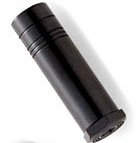
Calcite handheld dichroscope
There are two types of dichroscopes:
i) Calcite type:
A calcite dichroscope is a small cylindrical instrument with apetures on either side of the cylinder. One one side is the aperture to bring light into the instrument and on the other side is the lens with the eye piece.
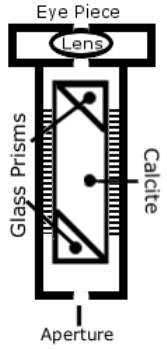
Diagram to show the internal structure of a calcite handheld dichroscope
Inside the calcite dichroscope two glass prisms and calcite rhomb are found. The glass prisms direct the light to pass through the eye piece while the calcite rhomb seperates the polarized slow and fast rays that are emerging from the gemstone. When one looks from the viewing end of the dichroscope two small windows should be seen.
Photo: Ganesh J. Acharya/ C.Commons
ii) Polarizing type:
This is a very economic alternative to the calcite dichroscope, but the results are inferior to that of calcite dichroscope. In this type the pleochroism is observed by using polarizing filters. The London dichroscope is a popular brand of polarizing dichroscope.
In the older models only one pleochroic color can be seen at a time and therefore subtle changes in color were difficult to recognize. In modern polarising dichroscopes this has been overcome by placing two polarising filters close together, oriented at 90° to each other.
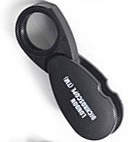
London Dichroscope
The dichroscope is very useful to seperate gemstones having similar appearance. Colorless gemstones cannot be tested using a dichroscope. If a gemstone (except colorless) is seen through the aperture and the instrument is rotated, it will show either one single color or two different shades of colors depending on the type of gemstone.

Dichroscopes by Kruess Optronics
Procedure for using the calcite dichroscope
The gemstone should be placed slightly touching the aperture. A strong source of white light such as a pentorch or fiber optic light should be placed behind the gemstone. The pleochroic colors of the gemstone are seperated by the calcite rhomb.
Two small windows will be seen next to each other when one looks through the viewing end of the dichroscope.These two windows will be colored. The colors may be the same or different shades of color or entirely different colors. The dichroscope should be turned slowly between the fingers up to 180° while keeping the gemstone in a fixed position. The colors in the two windows should be observed to see if they remain the same or change.The procedure should be repeated four times from different angles.
After examining the gemstone there are three possibilities:
i) The colors remain the same in both windows even when rotated in all directions.
The stone is isotropic (Single refractive). Only a few colored stones are single refractive.
ii) Two colors are observed.
The stone is anisotropic uniaxial.
There are two important exceptions. Peridot may appear uniaxial even though it is a biaxial gemstone. Low type zircon may show as isotropic.
iii) Three colors are observed.
The gemstone is anisotropic biaxial.
When three shades of color are seen the stone is biaxial without exception.
Summary of the use of dichroscopes
A dichroscope can be used to differentiate singly refractive gemstones (eg alamandine garnet & blue spinel) from double refractive gemstones withsimilar color (such as ruby and blue sapphire respectively).
The double refractive gemstones show the dichroic effect, that is two shades of color will be seen in ruby and blue sapphire but not in garnet or blue spinel.
5) Chelsea color filter
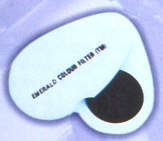
Chelsea color filter

Chelsea color filter
It looks like a pocket lens but has a dark filter. It is a simple and portable instrument that can be used in the feild as well as in a laboratory.
It is also known as emerald filter or color filter. A chelsea color filter absorbs visible light except deep red (long red wavelength) and yellow green. This filter is very useful to identify emerald simulants.
When emeralds (Natural & synthetic) are examined using a chelsea filter, it appears red even though emeralds appear green under ordinary light. All green pastes and most emerald simulants look green. Chromium colored gemstones will appear red, including chromium colored emerald simulants.
Most sapphires appear dirty green with the filter, while cobalt colored synthetic spinel, aquamarine and topaz also appear red with the filter.
6) Polarascope
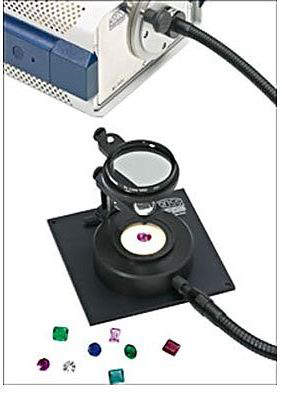
Kruess Optonics Polariscope
A polariscope is usually a small portable simple instrument used to determine if a gemstone is ingly refractive or not.
The light source from the bottom of the instrument has to pass through two crossed polaroid discs, oriented at right angles to each other. The gemstone should be placed between the two discs, on the stage of the polariscope. The lower polaroid disc is fixed and it is known as the polariser while the upper one is rotatable and is known as the analyser.

Pocket polariscope
Procedure:
Place the gemstone onthe stage of the instrument and slowly rotate it completely (360°). While rotating a double refractive gemstone will show four times light & four fimes dark. If the stone is singly refractive it will be dark all the way.
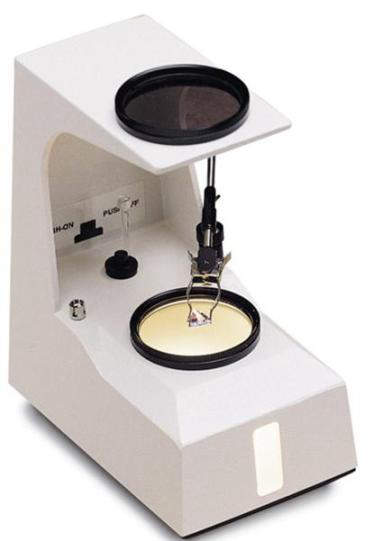
Polariscope by GIA
A polariscope can also be used to determine the pleochroism and optc figure (Uniaxial/biaxial) of a gemstone.
While observing pleochroism the gemstone should be rotated slowly, the color observed should switch with every 90° of rotation.The gemstone should be tested in many directions while examining for pleochroism. Only stones that are in a form of single crystal can be examined for pleochroism and optic figure of a gemstone. Aggregrate crystals cannot be examined for pleochroism and optic figure.
The examination of gemstones for pleochroism using a polariscope is not as accurate as using a dichroscope and in many cases it will have to be confirmed with a dichroscope.
Click here to go back to Part 1
You are welcome to discuss this post/related topics with Dr Shihaan and other experts from around the world in our FORUMS (forums.internetstones.com)
Click Here to go to Instruments in Gemology III
Back to Dr Shihaan's Guide to Buying Diamonds and Jewelry
Powered by Ultra Secure
Amazon (USA) Cloud Network

Founder Internet Stones.COM
Register in our Forums
| Featured In
|
|
|
|
|
|
|
|


















